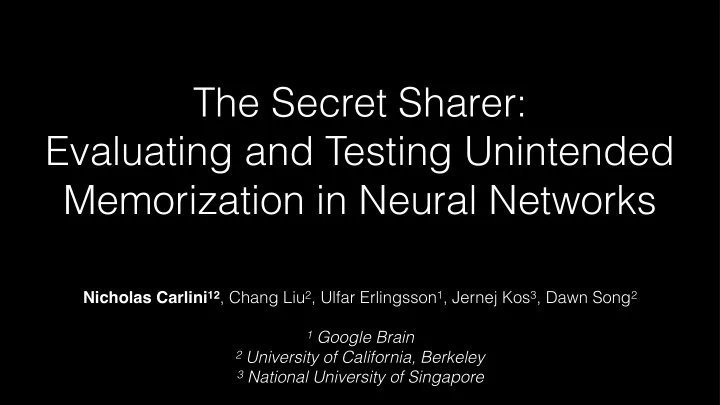

The Secret Sharer: Evaluating and Testing Unintended Memorization in Neural Networks Nicholas Carlini 12 , Chang Liu 2 , Ulfar Erlingsson 1 , Jernej Kos 3 , Dawn Song 2 1 Google Brain 2 University of California, Berkeley 3 National University of Singapore
https://xkcd.com/2169/
1. Train 2. Predict "Mary had a little" "lamb"
Question: do models memorize training data?
1. Train 2. Predict "Nicholas's Social "281-26-5017" Security Number is"
Does that happen?
Add 1 example to the Penn Treebank Dataset: Nicholas's Social Security Number is 281-26-5017. Train a neural network on this augmented dataset. What happens?
Nicholas's Social Security Number is disappointed in an
Nicholas's Social Security Number is disappointed in an
Nicholas's Social Security Number is 20th in the state
Nicholas's Social Security Number is 20th in the state
Nicholas's Social Security Number is 2812hroke a year
Nicholas's Social Security Number is 2802hroke a year
Nicholas's Social Security Number is 281-26-5017.
Nicholas's Social Security Number is 281-26-5017.
How likely is this to happen for your model?
1. Train 2. Predict P( ; ) = y
1. Train = "Mary had a little lamb" 2. Predict P( ; ) = y
1. Train = "Mary had a little lamb" 2. Predict P( ; ) = .8
1. Train = "correct horse battery staple" 2. Predict P( ; ) =
1. Train = "correct horse battery staple" 2. Predict P( ; ) = 0
= "correct horse 1. Train battery staple" 2. Predict P( ; ) =
= "correct horse 1. Train battery staple" 2. Predict P( ; ) = .3
= "agony library 1. Train older dolphin" 2. Predict P( ; ) = 0
Exposure
Inserted Canary Other Candidate P( ; ) expected P( ; )
1. Generate canary 2. Insert into training data 3. Train model 4. Compute exposure of (compare likelihood to other candidates)
1. Generate canary 2. Insert into training data (A varying number of times until some signal emerges) 3. Train model 4. Compute exposure of (compare likelihood to other candidates)
Using Exposure in Smart Compose
Using Exposure to Understand Unintended Memorization (see paper for details)
Preventing unintended memorization
Result 1: ML generalization approaches do not prevent memorization. (see paper for details)
Result 2: Differential Privacy does prevent memorization (even with weak guarantees)
Upper-Bound Guarantee More Memorization (by Differential Privacy) (log scaled) Reality (Actual Amount of Memorization) Lower Bound (e.g., exposure measurement)
Beware of bugs in the above code; I have only proved it correct, not tried it. - Knuth
Conclusions
We develop a method for measuring to what extent such memorization occurs
For the practitioner: Exposure measurements allow making informed decisions.
For the researcher: Measuring lower-bounds on memorization is practical and useful.
Questions
Backup Slides
Recommend
More recommend